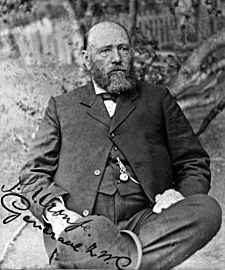Piet Cronjé facts for kids
Quick facts for kids
Piet Cronjé
|
|
|---|---|

Cronjé as a prisoner of war on Saint Helena
|
|
| Birth name | Pieter Arnoldus Cronjé |
| Born | 4 October 1836 Colesberg, Cape Colony |
| Died | 4 February 1911 (aged 74) Potchefstroom, Transvaal, Union of South Africa |
| Allegiance | |
| Service years | 1880–1902 |
| Rank | General |
| Wars | |
Pieter Arnoldus "Piet" Cronjé (born October 4, 1836 – died February 4, 1911) was an important Boer general from South Africa. He played a big role in the Anglo-Boer Wars, which took place from 1880–1881 and 1899–1902.
Contents
Early Life and First War
Piet Cronjé was born in the Cape Colony. However, he grew up in the South African Republic. People described him as a short man with a black beard. He was also known for being very brave.
Cronjé first became famous during the First Boer War. He led a siege against the British soldiers in Potchefstroom. A siege is when an army surrounds a place to cut off supplies. He managed to make the British surrender.
Role in the Jameson Raid
In 1896, Cronjé was in charge of the forces that stopped Leander Jameson. Jameson was a British colonial leader. He had led a failed raid into the South African Republic. Cronjé's troops captured Jameson and his men. This event was known as the Jameson Raid.
Second Boer War Contributions
During the Second Boer War, Cronjé was a general in the western part of the war. He started the sieges of two important towns: Kimberley and Mafeking.
Siege of Mafeking
At Mafeking, General Cronjé commanded a large force. There were between 2,000 and 6,000 of his soldiers. They surrounded the town, which was defended by about 1,200 British troops. The British were led by Colonel Robert Baden-Powell.
Battles and Tactics
Cronjé fought in several major battles. One was the Battle of Modder River on November 28, 1899. Here, the British won, but they lost many soldiers. This is called a Pyrrhic victory.
Cronjé used new fighting methods at Modder River. His soldiers hid at the bottom of hills. This helped their rifles shoot more effectively. These tactics were actually suggested by General Koos de la Rey and President Martinus Theunis Steyn.
After Modder River, Cronjé's forces stopped the British again. This happened at the Battle of Magersfontein on December 11. This success was also thanks to De la Rey's smart planning.
Surrender and Later Life
Cronjé was not a fan of battles that involved a lot of movement. He preferred to wear down the enemy. He was defeated at the Battle of Paardeberg. On February 27, 1900, he surrendered with 4,150 of his soldiers. This happened after Lord Roberts' forces surrounded them. Cronjé's wife, Hester, was with him during the campaign.
Prisoner of War
After his surrender, Cronjé and his wife were sent to a prison camp. This camp was on the island of Saint Helena. He stayed there until the war ended in 1902. His defeat lowered the spirits of the Boer forces. The capital of the Orange Free State, Bloemfontein, was then taken easily.
Post-War Activities
After the war, Cronjé faced some difficulties. Other Boer generals did not include him in peace talks. He was also made fun of in the newspapers.
In 1904, he took part in reenactments of the Anglo-Boer War. These shows were part of the World Fair in St. Louis, USA. He was called a "circus general" by the South African press. Instead of going home, he joined a show at Coney Island, Brooklyn. He eventually returned to South Africa and passed away in Klerksdorp.
Images for kids
See also
 In Spanish: Piet Cronje para niños
In Spanish: Piet Cronje para niños


